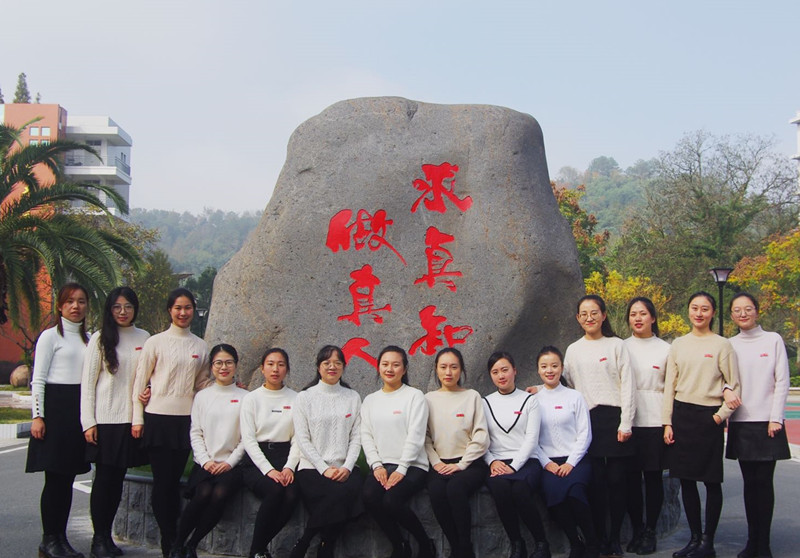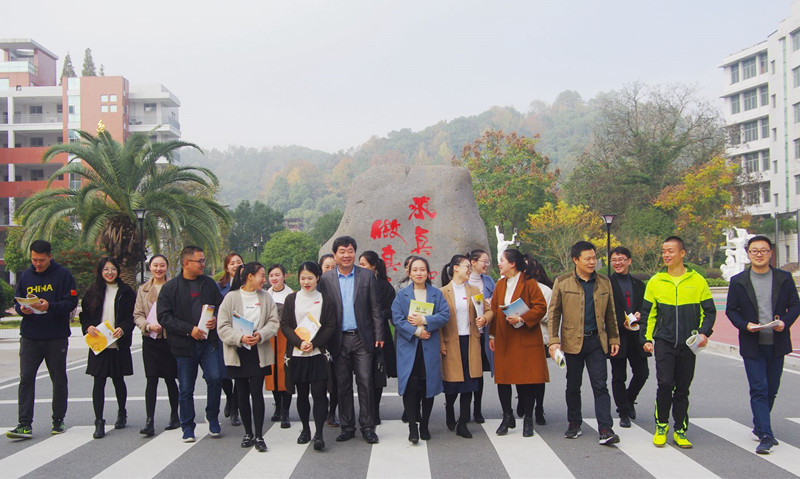教学设计-Getting The “Scoop”
|
教学设计内容 | ||||||
|
设计主题 |
人教版高二Book 5 Unit 4 Getting The “Scoop” | |||||
|
设计者 |
林 芬 |
工作单位 |
邵武一中 |
教学对象 |
高二 | |
|
课 时 |
1课时 |
联系电话 |
13365997583 |
指导教师(限报一人) |
无 | |
|
1.整体设计思路、指导依据说明 | ||||||
|
(1)2015年以《普通高等学校招生全国统一考试大纲》以及《福建省普通高中新课程教学要求》为指导的《考试说明》里,对阅读理解提出了六个要求:其一,理解主旨和要义;其五,理解文章的基本结构。英语文章讲究使用主题段和主题句。各个段落通常由某些起连接作用的词语连接,以使文章行文连贯。准确,深刻地理解文章,必须对文章的结构有所了解,把握住全篇的文脉,即句与句,段与段之间的逻辑关系。对这种能力的考察,直接反映在近两年全国高考新题型的七选五中。该题型尤其考察考生对文章的整体内容和结构以及上下文的逻辑意义的理解和掌握。 (2)因此,从学生和我校教学的实际出发,我将本文“Getting The Scoop”改造成了一篇七选五的文章。与以往的阅读教学不同,提高了难度。不仅要求学生在缺少五个句子的前提下阅读文章,把握文章大意,还优化学生的英语学习方法,使他们能通过观察,体验,探究等主动学习的方法,充分发挥自己的学习潜能,培养他们的创新精神和实践能力。由被动接受的学习转变为运用观察,发现,推测,理解,记忆,对比,分析,联想,归纳,内化等策略进行学习。同时我也由灌输式教学转为使用启发性教学,提供学生发现和探究的空间。 | ||||||
|
2.教学背景分析 | ||||||
|
教学内容分析: (1) 本单元的中心话题是“新闻”,内容涉及新闻工作者应该具备的素质和新闻采访的基本程序等。 (2) 本课 “Getting The Scoop”(获得独家新闻)是本单元“语言运用”(Using Language) 的阅读文章, 文章描述了新闻报道的步骤和见报前的有关程序。 (3) 本文从体裁上来看既是一篇记叙文,更是一篇说明文。非常详细地说明了制作新闻和报纸的流程。文章的结构与层次分明,能够最大程度地锻炼学生把握文章基本结构并逻辑分析上下文的能力。 (注:含本课时在本单元的教学定位分析) 学生情况分析: 教材最初的设计意图,是读,说和写三者相结合的。但是从我校学生的学情出发,一堂课很难有效地完成这三个目标。鉴于近两年高考新题型七选五,学生在平时的单元考试中,完成得非常不理想。经常会选错2题的同学几乎占50%,这对同学们来说是一个挑战。证明他们对文章结构的把握很不到位,只见树木,不见森林。逻辑关系混乱。 | ||||||
|
3.教学目标分析 | ||||||
|
(1)掌握与新闻制作相关词汇。 (2)了解新闻报道的步骤和见报前的有关程序。 (3)获得七选五的解题技巧。 | ||||||
|
4.教学重点、难点分析 | ||||||
|
教学重点: (1)words and expressions: section, technical, technically, thorough, gifted, housewife, crime, edition, ahead of, department, accurate, senior, polish, chief, approve, process, appointment (2)制作报纸的基本流程。 教学难点: (1)a senior editor, the copy-editor, the chief editor, the news desk editor. (2)概括文章大意。 (3)如何根据上下文将正确的选项填入空白处。并且分析说明选与不选的原因。 | ||||||
|
5.教学过程设计 (中文为主 + 所教学科目标语言) | ||||||
|
步骤1: Leading – in ( (1) T: Would you mind if there were no news? (板书) Ss: Yes, of course. (2) T: From where can we get information or news? (Play the PPT at the same time). Ss: Media. eg. ① Internet; ② Radio; ③Magazine; ④TV programmes; ⑤Book; ⑥ Other people; ⑦Newspaper. (3) T: But, do you often read newspaper? Ss: No. T: Why? Ss: (Any possible answers.) T: Yes. Because we prefer to get the news on TV or by surfing the internet. Because they are easier, more interesting, and even swifter. For instance, it is more convenient for me to take out my mobile phone to get myself involved in all kinds of information. (4) T: It seems that people do not want the news from a newspaper anymore. Newspaper seems out of date. However, for a very long time people depend on newspaper for nearly all the news. (5) T: In this period, we’re going to learn something about newspaper. 设计意图: 由于本课的内容是新闻报道的步骤和见报前的有关程序,但是,报纸对现在的学生来说似乎已经过时了。他们更多地是通过网络来了解新闻。所以通过让学生稍微了解报纸曾近的辉煌以及在人们日常生活中的重要作用来导入本课。 步骤2: Warming – up ( T: Well, before we read this text, let’s review some words related to it. Please match the words on the left with the explanations on the right. I’ll give you 1 minute to think it over first. (PPT) (1). edition a. having a higher position, level or rank (2).department b. most important (3). accurate c. to deal with (4). senior d. a section of a large organization (5). polish e. to make something shiny by rubbing it (6). chief f. correct and true in every detail (7). process g. the form a newspaper is produced in T: Now, let’s check the answers. 设计意图: 鉴于单词在上一堂课已经学习过了,作为本课课文出现的新词汇,在阅读前再次回顾复习一遍,以作为热身活动。 步骤3: Reading ( (将课文改造成了一篇七选五的文章,并印刷在试卷上分发给同学们) (1)T: Now, take out the papers I have handed out just now. Don’t open your books. Please look at page one. I have changed our text into a reading comprehension. More exactly, “Choose five out of seven”. (2)Fast – reading ( T: First of all, I will give you 5 minutes to read the text. Look through the text quickly and then tell me the general idea of it. Ss: The passage tells us the process of writing and printing for a newspaper article. (PPT) (3)Second – reading ( T: OK, I’ll give you another 5 minutes to do the exercise “Choosing five out of seven”. Be sure not to refer to your textbooks. Key: CGAFE (4)Discussion ( T: Well, please discuss with your partners about the reason why you make such a choice. If you feel it a little difficult, you can explain in Chinese. Ss: eg. ①C. key word: “interview”. Because according to the construction(板书) of the text, it’s the first step of making the newspaper. ②G. key word: his first task. Because it’s the second step according to the construction. ③A. the front sentence(板书): Why did he know how to do that? Because of months of training. ④F. the following sentence(板书): I’ll bring it to you immediately. Here “it” means the evidence. ⑤E. key words: “last check”, to be printed. That’s the last step of making the newspaper. (5)Discussion ( T: OK, please think it over why you don’t choose B & D? Ss: eg. ①B. By logic(板书). This sentence isn’t related to the context(板书). ②D. “They” refers to the readers instead of the workers. (6)Discussion ( T: Tell me the skills to do this kind of reading. Ss: (根据学生提供的答案板书在黑板上) (7)Conclusion ( T: To conclude, how to do this kind of reading? Ss: ①Get the general idea and the construction. ②Find out the key words and the logic in the context. ③Look through all the seven choices and get rid of the two wrong choices. ④Fill in the blanks and re-read it. (8)Careful – reading ( T: Now re-read the text and fill in the blanks. (PPT) ①. You go to an interview to _________________for your story. ②.You ________________to see if the story is true or not. ③. You begin to write the story using _______from the interview. ④. You give the article to the copy-editor to_______. ⑤. The article is given to a native speaker to __________________ ⑥. The last stage the article is _________________by the chief editor ⑦. All the stories and photos are set and _________________ for the printing are made ready. ⑧. The first edition of a news paper is made. Key: get the information; do some research; notes; design; polish the style; checked /approved; color negatives 设计意图: (1) 个人认为,阅读课就是要给学生们充分的时间阅读并理解。所以给学生阅读的时间足有10分钟。 (2) 这篇文章描述的是制作报纸的过程,所以结构性特别强,行文紧凑。所以我创造性地使用教材,将其改造成一篇七选五的阅读理解题。再结合近年的高考新题型讲解解题技巧。 (3) 遵循阅读规律,先快速阅读文章,掌握文章大意,同时也了解了文章的基本结构。再进行第二次阅读,七选五。并讨论,为什么作出这样的选择,为什么排除另外两项?通过分析原因,让学生们由被动接受的学习转变为运用观察,发现,推测,理解,记忆,对比,分析,联想,归纳,内化等策略进行学习,从而得出解题规律,比如找关键字,逻辑关系,上下文等等。 (4) 通过填空的方式,对文章再次详细阅读并深入地理解。 步骤4: Language points: (PPT) ( (1) Translations from Chinese into English. Find out the answers from the text. ① 着手工作 ② 真正的独家新闻(头条) ③ 制作一张彩页 ④ 国际新闻编辑部 Key: ① set to work ② a real scoop ③ make a colored page ④ International News Department (2) Translations from English into Chinese. Please underline these words and expressions in the text and then translate. ① a senior editor ② the copy-editor ③ chief-editor ④ the news desk editor ⑤ front page article ⑥ film negatives Key: ①编审 ②技术编辑 ③主编 ④新闻文字编辑 ⑤头版新闻 ⑥胶片 (3) What does “headline” mean? T: A headline is what attracts you to read the article so it is very important. It tells you about the topic of the article and tries to make it sound interesting and worth reading. It usually has a smaller heading (or sub-heading) underneath it to give the reader even more information. eg. “My first work assignment” “unforgettable,” says new journalist. 设计意图: 阅读课不仅仅是阅读,还要学会与本课相关的英语表达。如果学生们在阅读课后不能运用该课词汇,那也算是失败的。因此,还要扫清学生们有可能遇到的生词和难以理解的特殊表达。 步骤5: Review: ( Read the materials about the skills of choosing five out of seven that I’ve printed for the Ss. 设计意图: 再次用汉语给学生进行总结复习,以巩固他们在本课所学到的解题技巧。 步骤6: Self-assessment: ( Do the exercise on page two. (choose five out of seven) 设计意图: 这是从学生的练习册上节选的一篇比较短小的七选五的题目。通过课堂的当场演练,从理论到实际检查学生们的掌握情况。 (注意:每一教学步骤后要说明设计意图) | ||||||
|
6.教学评价设计 | ||||||
|
Exercise: choose 5 out of 7 1. If you are growing tomatoes in your backyard for sale, you are producing for the market. You might sell some to your neighbor and some to the local manager of the supermarket. But in either case, you are producing for the market. 2. If people stop buying tomatoes, you will stop producing them. If you take care of a sick person to earn money, you are producing for the market. If your father is a steel worker or a truck driver or a doctor or a grocer, he is producing goods or service for the market. 3. You may spend money in stores, supermarkets, gas stations and restaurants. Still you are buying from the market. When the local grocer hires you to drive the delivery truck, he is buying your labor in the labor market. 4. But for each person or business that is making and selling something, it is very concrete(具体的). If nobody buys your tomatoes, it won’t be long before you get the message. 5. It is telling you that you are using energies and resources in doing something the market doesn’t want you to do. A. The market may be something abstract. B. The sellers are always smarter than buyers. C. When you spend your income, you are buying things from the market. D. The market is a concept. (概念) E. One has to make his ends meet when shopping. F. The market is telling you something. G. Your efforts are being directed by the market. Key: DGCAF | ||||||
附(1):将课文改造成七选五的文章:
“Quick,” said the editor. “Get that story ready. We need it in this edition to be ahead of the other newspapers. This is a scoop.” 1. “Did he really do that?” asked someone from the International News Department. “Yes, I’m afraid he did,” Zhou Yang answered. He set to work.
2. Although he realized the man had been lying, Zhou Yang knew he must not accuse him directly. He would have to be accurate. Concise too! He knew how to do that. 3. He sat down at his computer and began to work.
The first person who saw his article was a senior editor from his department. He checked the evidence, read the article and passed it on to the copy-editor. She began to edit the piece and design the main headline and smaller heading. “This will look very good on the page,” she said. “Where is a good picture of this man?” Then as the article was going to be written in English Zhou Yang also took a copy to the native speaker employed by the newspaper to polish the style. She was also very happy with Zhou Yang’s story. “You are really able to write a good front page article,” she said. Zhou Yang smiled with happiness. Last of all, the chief editor read it and approved it. “Well done,” he said to Zhou Yang. 4. “I’ll bring it to you immediately,” said Zhou Yang excitedly.
The news desk editor took the story and began to work on all the stories and photos until all the pages were set. All the information was then ready to be processed into film negatives. This was the first stage of the printing process. They needed four negatives, as several colours were going to be used on the story. Each of the main colours had one negative sheet and when they were combined they made a coloured page for the newspaper. 5. . Zhou Yang waited excitedly for the first copies to be ready. “Wait till tonight,” his friend whispered. “I expect there will be something about this on the television news. A real scoop!”
A. Months of training had taught him to write with no wasted words or phrases.
B. Editors attempt to catch the reader’s interest with pictures and exciting headlines.
C. Zhou Yang had just come back into the office after an interview with a famous film star.
D. Sometimes, however, they don’t have time to read the news carefully.
E. After one last check the page was ready to be printed.
F. “But please show me your evidence so we’re sure we’ve got our facts straight.”
G. His first task was to write his story, but he had to do it carefully.
附(2): 给学生们印刷的更多的七选五解题技巧:
七选五
近年来,高考的阅读理解增加了信息匹配的 7 选 5 题型,主要考查考生对文章的整体内容和结构以及上下文逻辑意义的理解和掌握。其命题体现了《新课标》“用英语获取、处理和运用信息的能力;逐步获取用英语思维的能力。”的阅读学习和教学理念。《考试说明》对该题型命题目的的表述“主要考查考生对文章的整体内容和结构以及上下文逻辑意义的理解和掌握。”
从题型和内容我们可以看出,题备选项可分为.a.主旨概括句(文章整体内容)、b.过渡性句子(文章结构)c.注释性句子(上下文逻辑意义)三类。其多余的两个干扰项也往往从这三方面进行设置,如主旨概括句或过于宽泛或以偏概全或偏离主题,过渡性句子不能反映文章的行文结构,注释性句子与上文脱节等。
一、题型分析
分析篇章结构,把握全篇文脉是阅读填空题解题的关键。分析文章的层次包含两种形式:一种是分析整篇文章的层次,也就是段落,另一种是分析每一个段落内部的层次,也就是语篇层次。
语篇与段落是有区别的,语段是篇章结构的中间层次,是由句子到篇的一种过渡形式,段落是在某些语体(如记叙文、议论文)中比语段更大的意义单位,较小的段落可以只包括一个语段或一个句子,一般来说,一个段落通常由几个语段构成。构成语段的方式有两种,一是靠句际间意义的结合,二是靠句际间的关联词,逻辑性插入语来连接,在分析语段层次时,可以借助句际间的连接词语作出判断,但最主要的还是要真正体会句际间的意义关系,把握作者的思路,从语序上去发现断续点,理清层次,好文章的层次非常清晰,只有层层入手,才能真正理解文章。
二、解题策略
1.理清句际间意义的关系
文章的内容是根据各层各段的大意有机地组合而成,各个层次,各个段落之间不管怎样错落有致,但它所表达的内容都是要围绕中心的,各句之间都有一定的语脉,从逻辑意义上来看,语段的句际关系可分为平列、顺序、层递、转折、总分、解释、因果等关系。构成语段的各个句子之间有时可以包含一种以上的句际关系。因此,理解阅读材料时一定要把握语脉,理清句际间的关系,进而理解语段或全文的内容。
2.找出句子之间的连接性的词语
文章的语句间的组合,除了从语句间的意义关系分析外,还可借助句子之间的连接性词语来把握,因为连接性词语能表明这个语段句与句之间、层与层之间的基本关系有承接关系(如 so, therefore, thus, hence, accordingly, consequently, as a result 等)平列关系(如first, second, third…; firstly, secondly, thirdly…; first, next, then …; in the first place, in the second place…; for one thing, for another thing…;to begin with, to conclude 等)。转折关系(如 however, nevertheless, still, though, yet, in spite of, at any rate, in any case, whoever, whatever, on the contrary, in contrast, by contrast, in comparison, by comparison, conversely, otherwise 等)。层递关系(如 also, further, furthermore, similarly, moreover, in addition, what’s more, too, either, neither, not…but…, not only…but also 等)。解释关系。
三、实施步骤
对一个语段或语篇的分析,可以按以下步骤进行:
1.通读全文对文章进行快速浏览,寻找主题句,抓住文章结构及文章的写作内容。
在阅读过程中,要注意文章的开始与结束段落,尤其是文章的首段及末段末句,因为“开门见山”与“结尾总结”的写作方式为常见的写作方式,首段的末句一般是是全文的主题所在,说明本文将探讨哪些内容,并简要指出文章的写作思路,有时甚至会以提纲的形式进行呈现。首段的末句对于快速掌握文章的主题具有重要意义,如果它是文章的主题句,就可以使读者迅速明确文章情节将如何展开,并对文章的写作主题有了整体的了解。如果末句不是主题句,则需要继续寻找。这时,可以考虑文章的写作方式是否为“结尾总结”式,如两者均可排除,则需在文章中其他段落寻找主题句,但要注意,首段与末段的提示作用。
2.详读段落在短时间内,找出每段写作内容的关键词。明确各段的主题句或主旨大意。
文章正文部分通常分为若干小段落。各段落会根据整体文章写作主题展开,对文章主体进行的不同方面的描述。找出各个小段落中的关键词,明确其描述内容,为整体试题的解决做好铺垫。
3.定位选项明确各备选选项的含义,抓住其关键词语,根据文章整体结构与具体内容,将选项填入文中,填写时尤为注意各选项中出现的句子衔接手段及句中的衔接标志词。
在定位选项时,要特别注意空格上下段的写作内容,以及空格上段尾句和下段首句的结构和意义。将所选项放入空白处,看看是否与上下文构成语义及逻辑上的直接关系,是否符合该处语境。能否承接前后的写作线索。使文章无论内容还是衔接上都能做到通顺。
4.通读复检将所选答案代入文中,再次通读全文,重点考查逻辑关系和关联结构。
在完成选项定位后,应通读全文,检查文章内容是否完整,语义是否连贯合理、各段落内容是否紧扣主题,语篇结构是否通顺连贯、具有一致性、合乎逻辑,写作思路是否清晰明了,格式以及用语是否恰当贴切,从而判断选择的答案是否正确。同时,我们还应注意对相近选项的对比分析,个别干扰项由于与某个正确选项的内容相近具有很强的干扰性,这时就需要我们认真分析,仔细甄别,排除干扰,从而得出正确选项。
要特别注意,除非有充分的理由否定向前的选择,否则不要仓促更改。只要前两步投入了精力,动了脑筋,第一印象往往可信度很高。
5.确定排除研究多余选项,确定排除理由,最终确定答案。
- 通知公告 更多









